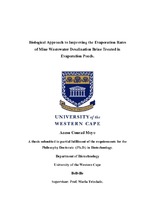| dc.contributor.advisor | Trindade, Marla | |
| dc.contributor.author | Moyo, Anesu Conrad | |
| dc.date.accessioned | 2021-03-17T07:59:51Z | |
| dc.date.available | 2021-03-17T07:59:51Z | |
| dc.date.issued | 2021 | |
| dc.identifier.uri | http://hdl.handle.net/11394/7982 | |
| dc.description | Philosophiae Doctor - PhD | en_US |
| dc.description.abstract | The disposal of brine effluent from inland wastewater desalination plants is a
growing global problem with adverse economic and environmental implications
because of the substantial cost associated with its disposal and the potential for
polluting groundwater resources. Currently, the best and most economical option
for brine disposal from inland desalination plants is the use of evaporation ponds,
which concentrate the liquid until getting a solid waste that can be valued or
directly managed by an authorized company. The effectiveness of these ponds is
therefore dependent on the evaporation rate, which has previously been improved
by the addition of dyes such as methylene blue. However, the addition of chemical
dyes to the evaporation ponds poses a threat to the environment, wildlife, and
humans. | en_US |
| dc.language.iso | en | en_US |
| dc.publisher | University of the Western Cape | en_US |
| dc.subject | Evaporation rate | en_US |
| dc.subject | Evaporation ponds | en_US |
| dc.subject | Desalination brine | en_US |
| dc.subject | Halophilic bacteria | en_US |
| dc.subject | Pigments | en_US |
| dc.title | Biological approach to improving the evaporation rates of mine wastewater desalination brine treated in evaporation ponds | en_US |
| dc.rights.holder | University of the Western Cape | en_US |

